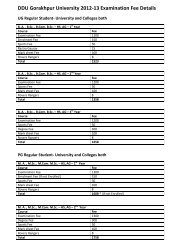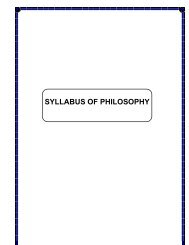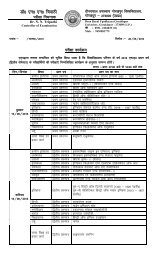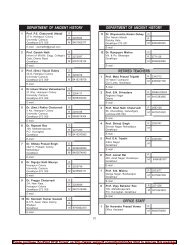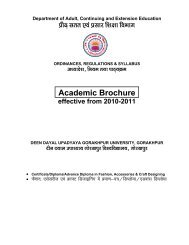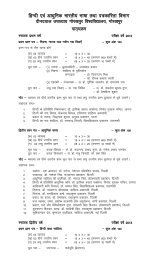DDU Gorakhpur University Gorakhpur - Deen Dayal Upadhyay ...
DDU Gorakhpur University Gorakhpur - Deen Dayal Upadhyay ...
DDU Gorakhpur University Gorakhpur - Deen Dayal Upadhyay ...
You also want an ePaper? Increase the reach of your titles
YUMPU automatically turns print PDFs into web optimized ePapers that Google loves.
Semester I<br />
<strong>DDU</strong> <strong>Gorakhpur</strong> <strong>University</strong><br />
<strong>Gorakhpur</strong><br />
MA/M.Sc. in Defence and Strategic Studies<br />
(Semester System)<br />
SYLLABUS<br />
(To be implemented from the Academic year 2011-2012)<br />
List of Papers<br />
Paper I : Evolution of Indian Art of War up to 1857<br />
Paper II : National Security<br />
Paper III : Armament, Disarmament and Arms Control<br />
Paper IV : Human Rights and International Law<br />
Paper V : Practical and Viva-Voce<br />
Semester II<br />
Paper VI : Research Methodology<br />
Paper VII : Peace and Conflicts Studies<br />
Paper VIII : Insurgency and Terrorism<br />
Paper IX : India’s National Security and Strategic Spectrum<br />
Paper X : Practical and Viva-Voce<br />
Semester III<br />
Paper XI : Defence Economics<br />
Paper XII : Geo-politics and Military Geography<br />
Paper XIII : Science, Technology and National Security<br />
Paper XIV : South Asia: Conflict-cooperation Studies<br />
Paper XV : Practical and Viva-Voce<br />
Semester IV<br />
Paper XVI : Strategic Thought<br />
Paper XVII : International Relations<br />
Paper XVIII : Politics and Security of the Indian Ocean<br />
Paper XIX : Dissertation or conflict and Media or Science and<br />
Technology and Non-traditional Security or Refugees and<br />
Migration Study<br />
Paper XX : Practical and Viva-Voce<br />
1
Paper I<br />
(Evolution of Indian Art of War up to 1857)<br />
1. Basic concept and a brief survey of the military traditions of India.<br />
2. Military system and Defence Mechanism in Vedic, Puranic and Epic Age.<br />
3. Comparative study of Indo-Greek art of warfare with special Reference to<br />
Battle of Hydaspes 326(BC).<br />
4. Maurya’s military system, Kautilya’s philosophy of war, concept of Defence,<br />
Security and Inter-State Relations.<br />
5. Comparative study of Indo-Turk Art of war with special reference to Battle of<br />
. Terrains (1191&1192AD)<br />
6. Mughal Military System with special reference to Battle of Panipat (1526 AD).<br />
7. Maratha Military System with reference to irregular warfare of Shivaji.<br />
8. Anglo- Maratha war with special reference to Battle of Assaye 1803(AD)<br />
9. Contribution of Maharaja Ranjeet Singh in Evolution of Shikh Military System.<br />
10. Causes & importance of First War of Independence 1857.<br />
(Books & Journals articles recommended by the teachers)<br />
2
Paper II<br />
(National Security)<br />
1. Evolution of the concept of National Security with reference to<br />
contemporary thinking.<br />
2. Components of National Security.<br />
3. Comprehensive Security: meaning and scope<br />
4. Defence, Foreign, Security and Domestic policies: concepts, formulation,<br />
objectives and linkages.<br />
5. Defence co-operation, Strategic partnership and security dialogue: new<br />
trends in 21 st century.<br />
6. Problems of system of Governance and Human Rights.<br />
7. India: threats and challenges from within.<br />
8. National Security in the age of Globalization: new threats and challenges.<br />
9. Civil- Military relations in India.<br />
10. Human Security: concept and dimensions in Indian context.<br />
11. Energy Security: issues in Indian context.<br />
12. Environmental security: Indian scenario.<br />
(Books & Journals articles recommended by the teachers)<br />
3
Paper III<br />
(Armament, Disarmament and Arms Control Studies)<br />
1. Armament: Meaning, Development and New trends.<br />
2. Basic Concepts and theories-<br />
(i) Concept and correlation between Disarmament & Arms Control<br />
(ii) Objectives and conditions of Disarmament & Arms Control.<br />
(iii) Elements of Arms Control Mechanism: Agreements,<br />
Verification, Inspection, Control.<br />
3. Measures of Arms Control & Disarrangement.<br />
4. Weapons of Mass Destruction- Nuclear Weapons. Chemical, Biological<br />
and Weather Weapons.<br />
5. Conventional Disarmament and Arms Control efforts: Regional context.<br />
6. Concept of Non- Proliferation, NPT, CTBT, PTBT, CB Conventions &<br />
other Treaties,<br />
7. Nuclear Export Control Regimes; IAEA.<br />
8. National Policies of United States, Russia, China, UK, France towards<br />
Nuclear Non- Proliferation and N- Arms control.<br />
9. National Policies And Approaches towards Nuclear Arms-India, Pakistan,<br />
Israel, North Korea, Iran and other Potential Proliferators,<br />
10.Trends in Military Expenditures: India and the World,<br />
11.Social and Economic consequences of Disarmament & Arms Control.<br />
(Books & Journals articles recommended by the teachers)<br />
4
Paper IV<br />
(Human Rights and International Law)<br />
1. Human Rights: Concept & Nature, Historical Background Origin &<br />
Development, Classification<br />
2. Introduction of International Law, Relation between Human Rights<br />
&International Law.<br />
3. Universal Declaration of Human Rights, Human Rights in Indian<br />
Constitution<br />
4. Concept & theories of Humanitarian Law.<br />
5. Geneva Convention for the Amelioration of the Condition of the Wounded<br />
and Sick in Armed Forces in field, at Sea, Protection of Civilian Persons in<br />
Times of war, Treatment of Prisoners of war.<br />
6. Peaceful means of Settlement of Disputes<br />
7. Limits on the choice of means and methods of warfare.<br />
8. Modern Developments and Laws of Neutrality<br />
9. General Rules of land, air and sea warfare<br />
10. Blockade: Conception, Breach and Penalties.<br />
Books:-<br />
Human Rights in the Modern World R.S.Agrawal<br />
Human Rights in India G.S.Bajwa<br />
Human Rights in Constitutional Law D.D.Basu<br />
Human Rights in Changing World Antari Casser<br />
Human Rights Pr. T.P.Trapathi<br />
Human Rights Dr. J.J. Ram <strong>Upadhyay</strong><br />
Indian Constitution Dr. J.N.<strong>Upadhyay</strong><br />
ekuo vf?kdkj ,oa vUrjkZ’Vh; fof?k Mk0 ,l0ds0 diwj<br />
ekuo vf?kdkj Mk0 ,p0vks0 vxzoky<br />
(Books & Journals articles recommended by the teachers)<br />
5
Paper V<br />
(Practical and Viva-Voce)<br />
Students will be expected to mark the areas in the map provided and to write a<br />
brief note about the Spots.<br />
1. Zonal Headquarters of Indian Army.<br />
2. Zonal Headquarters of Indian Air force.<br />
3. Important Naval bases and ports of India.<br />
4. Important Nuclear and space Research establishment in India.<br />
5. Defence Research and Development Organization in India.<br />
6
Paper VI<br />
(Research Methodology)<br />
This introduces the students to various tools to various tools and approaches<br />
used in social sciences and the formulation of a Research Framework.<br />
1. Nature of Social sciences and Research<br />
2. Recent trends in Social Science Research<br />
3. Descriptive and Historical Methods<br />
4. Scientific Approaches<br />
5. Planning a research Project<br />
7
Paper VII<br />
(Peace and Conflict Studies)<br />
1. Peace and Conflict Studies: Meaning, Nature and Scope<br />
2. Conceptual analysis of Conflict and Peace<br />
3. Conflict management in the regional context<br />
4. Gandhian Approach and its relevance today for Conflict Resolution<br />
5. Causes of war<br />
6. Regional Conflicts and Role of United Nations<br />
7. Confidence & Security Building Measures ( CSBM)<br />
8. Peace Building, Peace Making, Peace Keeping and Peace Enforcement<br />
9. Pacific and Coercive Settlement of Dispute<br />
10. Peace Research and Peace Movements<br />
11. Concept and theories of Conflict Resolution; IGOs and NGOs in Conflict<br />
Resolutions.<br />
Books recommended:<br />
- K.E.Boulding, Conflict and Defence : A General Theory,<br />
Newyork,1962<br />
- Anima Bose (ed), Peace and Conflict Resolution in World<br />
Community, New Delhi, 1919<br />
- Bhasksr Roa, Global Perceptions on Peace Education, New Delhi,<br />
1996.<br />
- Peter Ackerman & Jack Duvall, A Force More Powerful : A Century<br />
of Non-Violent Conflicts, New York, 2000.<br />
8
- B. Boutros- Ghali, An Agenda For Peace : Preventive Diplomacy,<br />
Peace Making and Peace Keeping, (U.N.Report) New York, 1992.<br />
- B.U.Bright, Educating for Peace, New York, 1985.<br />
- Adam Curle, Another Way : A Mechanistic View of War and<br />
Peace,Cambridge, 1927.<br />
- A.C.Dasgupta, Non-Violence : The Invincible Power, Calcutta. 1956.<br />
- Lewis Caser, Functions of Social Conflict, New York, 1956.<br />
- J.W.Burton, International Conflict Resolution, New York, 1965.<br />
- Ghanshyam Purdeshi (ld.), Contemporary Peace Research, New<br />
Delhi, 1982<br />
- Johan Galtung, Struggle for Peace, Ahmedabad, 1984.<br />
- Johan Galtung, Peace by Peaceful Mean : Peace and Conflict,<br />
Development and civilization, Sage Pub, 1996<br />
- Johan Galtung. Essays in Peace Research, Copenhagen, 1975.<br />
- Quincy Wright, A Study of War, Chicago, 1965.<br />
Other books & Journals articles recommended by teachers.<br />
9
Paper VIII<br />
1. Insurgency: concept and principles.<br />
(Insurgency and Terrorism)<br />
2. Methods and techniques of Guerilla and counter – Guerilla warfare.<br />
3. Impact of Marxist, Leninist and Maoist ideologies on revolutionary<br />
movements.<br />
4. Urban Guerilla warfare.<br />
5. Guerilla and counter-Guerilla operations in Malaya and Indo-China.<br />
6. Current trends of Insurgency and counter-Insurgency in South Asia and<br />
the role and limitations of Military in counter-Insurgency situations.<br />
7. Terror and Terrorism: concept, characteristics and typology.<br />
8. Methods and techniques of terrorism.<br />
9. Causes of terrorism in India and underlying remedies.<br />
10. Asymmetric warfare in the contemporary age.<br />
11. International terrorism and problems of world peace and security.<br />
12. International and regional arrangements and co-operation for curbing<br />
terrorism.<br />
(Books & Journals articles recommended by the teachers)<br />
10
Paper IX<br />
(India’s National Security & Strategic Spectrum)<br />
1. Introduction: Political, Societal, Economic, Religious and Regional<br />
Dimensions of Internal conflict in India.<br />
2. State: Different Models of State Organization<br />
3. Conflict Prone and conflict resolving States.<br />
4. Multiculturalism, Pluralism and Diversity.<br />
5. Nature of Conflict and Conflict resolution in India during pre and post.<br />
Independence era Movements.<br />
6. Agitations; types and nature.<br />
7. Method of conflict resolutions.<br />
8. Case Studies, Naxalite Movement, Successful counter insurgency<br />
operations in Punjab, Insurgency in North- East Jammu and Kashmir<br />
9. Regional, Ethnic, Culture Linguistic separatist movements with special<br />
reference to Linguistic Movements in Tamil Nadu, Maharashtra, Punjab<br />
and Haryana, Gorkhaland and Telangana.<br />
10. Terror strikes in metro cities as a New challenge to Internal security.<br />
(Books & Journals articles recommended by the teachers)<br />
11
Paper X<br />
(Practical and Viva-Voce)<br />
Students will be expected to mark the areas in the map provided and to write a<br />
brief note about the Spots.<br />
1. Disputed land Areas with bordering States-<br />
(a) Pakistan<br />
(b) China<br />
(c) Nepal<br />
(d) Bangladesh<br />
2. Disputed Sea Areas with bordering States-<br />
(a) Pakistan<br />
(b) Bangladesh<br />
3. Conflict Zones of South Asia-<br />
(a) India<br />
(b) Pakistan<br />
(c) China<br />
(d) Nepal<br />
(e) Bangladesh<br />
(f) Sri Lanka<br />
12
Paper XI<br />
(Defence Economics)<br />
1. Concept of theories of war – economics war as an economics problem.<br />
2. Economics Potential of war<br />
3. Cost of war<br />
4. Economics Warfare<br />
5. War finance<br />
6. Post- War economy<br />
7. Defence Budget and National Security<br />
8. Defence Production in India<br />
9. Economic Problem and Planning for India Defence<br />
10. The new internal economic order.<br />
11. Comparative Study of Defence Budget of India , Pakistan & China<br />
Books:<br />
The Economics of war Pal Poast<br />
Economic Warfare Yuan-li –Wu<br />
lEiw.kZ lSU; foKku iq’ik tSu<br />
;kSf)d vFkZ”kkL= Mk0 ,l0Mh0 ”kekZ<br />
(Other books & Journals articles recommended by the teachers)<br />
13
Paper XII<br />
(Geo- Politics and Military Geography)<br />
1. Scope and Importance of geopolitics<br />
2. Evolution of Geopolitical Thoughts since 19 th Century:<br />
(a) Sea Power Theory<br />
(b) Land Power Theory<br />
(c) Rim Land Theory<br />
3. A.T. Mahan- Concept of Sea Power & Strategy<br />
4. Mackinder – Heart land theory<br />
5. Role of Geography in Military applications<br />
6. Importance and Scope of Logistics : (a) Resources (b) Industries (c)<br />
Supply Chain (d) Transportation and Communication<br />
7. Role of Geography in Land Warfare<br />
8. Role of Geography in Sea Warfare<br />
9. Role of Geography in Air Warfare<br />
10. Weather conditions of Sea as factors in amphibious and airborne<br />
11. Military Geography of India, Defence Problems: (a) India’s boundaries,<br />
terrain in border areas, weather and commoditization, (b) population in<br />
border areas and its implications to border security<br />
(Books & Journals articles recommended by the teachers)<br />
14
Paper XIII<br />
(Science, Technology and National Security)<br />
1. Science, Technology and Society: history and impact of major<br />
technological breakthroughs on society.<br />
2. Applicability of Physical, Mathematical and Technical Sciences in the<br />
. field of defence.<br />
3. Chemical-Biological Sciences and their military utility.<br />
4. Nuclear and Missile Technologies and related developments.<br />
5. Revolution in Military Affairs (RMA) and India’s National Security.<br />
6. Advancing military technologies and their impact on weapon<br />
. development and defence industrialization.<br />
7. International interdependence and transfer of defence technology :<br />
. Global trends and Indian scenario.<br />
8. Critical & Dual technologies and India’s defence needs.<br />
9. DRDO and Indian Defence.<br />
10. Impact of Science and Technology on Conventional Weapon . .<br />
. Systems.<br />
11. Computerization and Cyber technologies, Aero-space technologies<br />
. Marine Technology and Ocean development: Indian scenario.<br />
Books recommended:<br />
- K.E.Boulding, Conflict and Defence : A General Theory,<br />
Newyork,1962<br />
- Anima Bose (ed), Peace and Conflict Resolution in World<br />
Community, New Delhi, 1919<br />
- Bhasksr Roa, Global Perceptions on Peace Education, New Delhi,<br />
1996.<br />
15
- Peter Ackerman & Jack Duvall, A Force More Powerful : A Century<br />
of Non-Violent Conflicts, New York, 2000.<br />
- B. Boutros- Ghali, An Agenda For Peace : Preventive Diplomacy,<br />
Peace Making and Peace Keeping, (U.N.Report) New York, 1992.<br />
- B.U.Bright, Educating for Peace, New York, 1985.<br />
- Adam Curle, Another Way : A Mechanistic View of War and<br />
Peace,Cambridge, 1927.<br />
- A.C.Dasgupta, Non-Violence : The Invincible Power, Calcutta. 1956.<br />
- Lewis Caser, Functions of Social Conflict, New York, 1956.<br />
- J.W.Burton, International Conflict Resolution, New York, 1965.<br />
- Ghanshyam Purdeshi (ld.), Contemporary Peace Research, New<br />
Delhi, 1982<br />
- Johan Galtung, Struggle for Peace, Ahmedabad, 1984.<br />
- Johan Galtung, Peace by Peaceful Mean : Peace and Conflict,<br />
Development and civilization, Sage Pub, 1996<br />
- Johan Galtung. Essays in Peace Research, Copenhagen, 1975.<br />
- Quincy Wright, A Study of War, Chicago, 1965.<br />
(Other books & Journals articles recommended by teachers)<br />
16
Paper XIV<br />
(South Asia: Conflict and Co-operation)<br />
1. Geo-Political setting of South Asia.<br />
2. Socio-Cultural and Economic structure of South Asia.<br />
3. Power rivalries in South Asia: USA., USSR., U.K., China during Cold War<br />
era.<br />
4. Internal problems & conflicts in South Asian Region-Indias Pakistan, Sri<br />
Lanka, Bangladesh, Nepal, Bhutan, Maldives .<br />
5. Afghanistan, Myanmar& China’s Strategic importance for South Asia.<br />
6. Regional Co-operation in South Asia under the Aegis of SAARC.<br />
7. Intra- Regional Trade & Balance of Payment.<br />
8. Prospects of Sub regional Co-operation.<br />
9. Role of pressure groups (Religion, Language, Caste, Tribal Groups,<br />
Women, Youth, Media) in National Integration.<br />
10. Pattern of Civil-Military Relations in South Asia.<br />
(Books & Journals articles recommended by the teachers)<br />
17
Paper XV<br />
(Practical and Viva-Voce)<br />
The students will be assigned with the responsibility to prepare/ conduct<br />
Computer-based exercised or Computer experiments on selected topic of<br />
contemporary relevance in the filed of National Security for the following-<br />
1- To prepare Computer graphics.<br />
2- Lecture on the selected topics.<br />
3- Power-Point presentation on the given topic.<br />
4- Viva-Voce<br />
18
Paper XVI<br />
(Strategic Thought)<br />
1. Machiavelli: The Renaissance of the Art of War<br />
2. Napoleon: Element of Napoleonic war, concept of Strategy and Tactics<br />
3. Clausiwit: On war and its relationship with Politics, Strategy and<br />
Tactics<br />
4. Jomeni: Concept of Mass Army, Strategy, Tactics and Line of<br />
Operations.<br />
5. Moltke & Schlieffen: The Prussian-German School of strategic thought<br />
6. Foch: The French School of strategic thought .<br />
7. First- World War: Causes, policies of Allied and Axis Powers, causes<br />
of stalemate, use of Tank.<br />
8. Fuller, Liddell Hart: Concept of Armoured and Mechanized Warfare.<br />
9. Second World War: Strategic doctrine and tactics<br />
10. Douhet : Theories of Air Power and Strategic Bombing during W.W.II<br />
(Books & Journals articles recommended by the teachers)<br />
19
Paper XVII<br />
(International Relations)<br />
1. International relations: meaning, nature and scope.<br />
2. Theories and Approaches:<br />
(a) i. Realism<br />
ii. Idealism.<br />
(b) i. Historical approach<br />
ii. Legalistic and institutional approach<br />
iii. Utopian or ideal approach<br />
iv. Realistic Approach<br />
v. Behavioral Approach<br />
vi. System Approach<br />
3. Foundation and limitation of National Power, National Interest and Foreign<br />
. Policy.<br />
4. Theories of Balance of Power and Collective Security.<br />
5. Non- alignment: concept and importance in modern time .<br />
6. Development of international relations between-<br />
i- India and USA<br />
ii- India and Russia<br />
iii- India and China<br />
iv- India and Pakistan<br />
7. Cold war: nature and evolution since 1945.<br />
8. New cold war.<br />
9. Regional or organization-SAARC, ASEAN, EEC.<br />
10. Principles of India’s foreign policy. .<br />
(Books & Journals articles recommended by the teachers)<br />
20
Paper XVIII<br />
(Politics and Security of the Indian Ocean)<br />
1. Indian Ocean region as a concept and reality.<br />
2. Coastal states, hinterland states and island:<br />
(i) The Political characteristics of the region .<br />
(ii) Demographic survey<br />
(iii) The sub region<br />
3. Political, Strategic ,Economic and Military importance of Indian Ocean<br />
(i) Ideologies in Indian Ocean<br />
(ii) Economic and strategic interdependence of the region<br />
(iii) Super power vs. Middle Powers and militarization of the region<br />
(iv) Strategic Importance of the region: Militarily and Economically<br />
4. Sub- regional Perspective :<br />
(i) Persian gulf<br />
(ii) Red Sea & Horn of Africa<br />
(iii) Eastern and Southern Africa<br />
(iv) South Asia<br />
(v) Australia and eastern Approaches<br />
5. Major Sea routes in the region.<br />
6. Interests of External Powers: USA, Russia, China, Japan , Western Europe.<br />
7. Future trends and prospects of security in the region .<br />
8. Navel bases in the Indian Ocean Area during the Cold War and after.<br />
9. Maritime Strategy of India.<br />
10. Prospects of Cooperation in the Indian Ocean Region.<br />
(Books & Journals articles recommended by the teachers)<br />
21
Paper XIX (ii)<br />
(Science & Technology and Non-Traditional Security)<br />
1. Non-Traditional Security (NTS): concept, nature & scope<br />
2. Science, technology and Indian life: food, nutrition and human health<br />
concerns.<br />
3. Energy security and conventional sources.<br />
4. Non-conventional options for India’s Energy Security.<br />
5. India’s resource base.<br />
6. Use of science and technology for the exploitation of resources in India’s<br />
civilian sector.<br />
7. Need for the use of science and technology for the exploitation of<br />
resources in India’s Defence sector.<br />
8. Science and technology and hazards for human life.<br />
9. Technological disasters and risk reduction.<br />
10. Industrial disasters and risk reduction.<br />
11. India’s integrated science policy for NTS management.<br />
(Books & Journals articles recommended by the teachers)<br />
22
Paper XX<br />
(Practical and Viva-Voce)<br />
The students will be assigned with the responsibility to prepare/ conduct<br />
Computer-based exercised or Computer experiments on selected topic of<br />
contemporary relevance in the filed of International Security for the following-<br />
1- To prepare Computer graphics.<br />
2- Lecturette on the selected topics.<br />
3- Power-Point presentation on the given topic.<br />
4- Viva-Voce<br />
23



